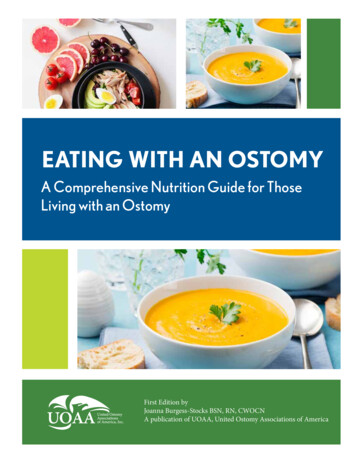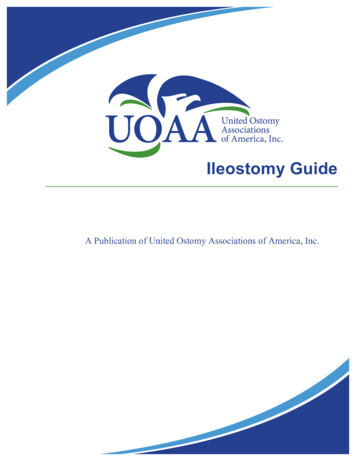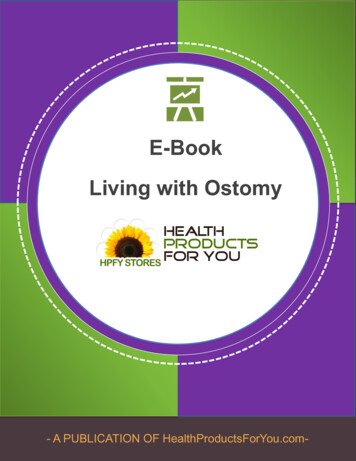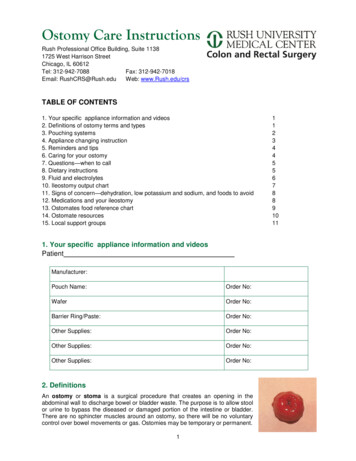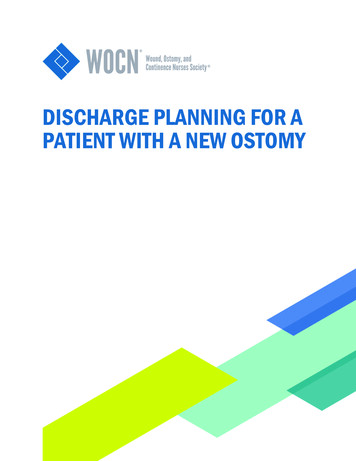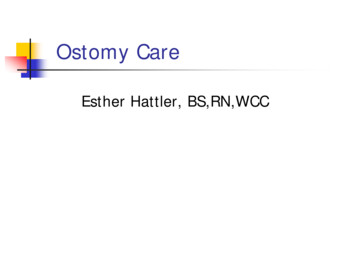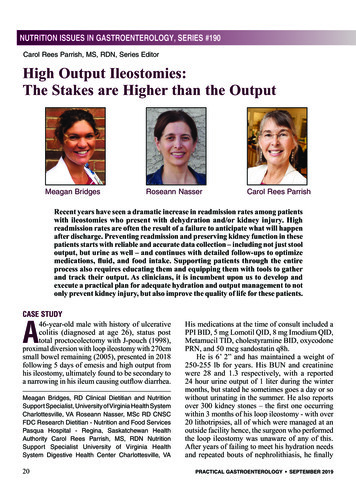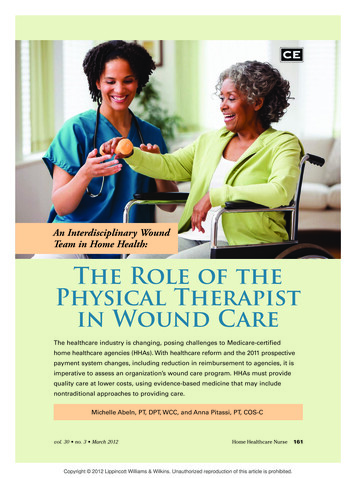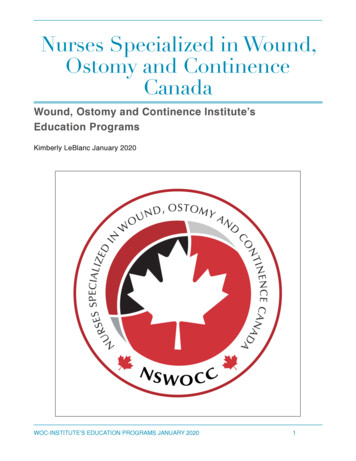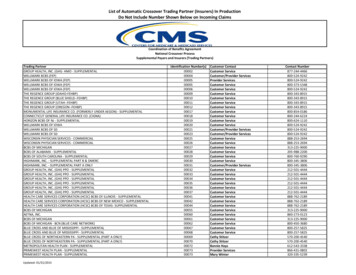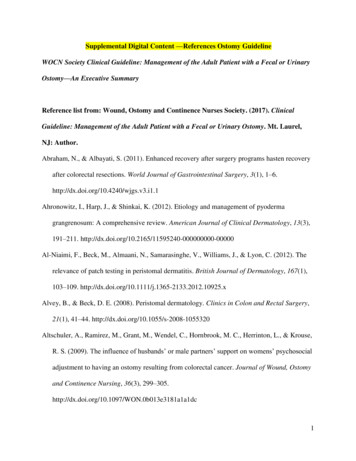
Transcription
Supplemental Digital Content —References Ostomy GuidelineWOCN Society Clinical Guideline: Management of the Adult Patient with a Fecal or UrinaryOstomy—An Executive SummaryReference list from: Wound, Ostomy and Continence Nurses Society. (2017). ClinicalGuideline: Management of the Adult Patient with a Fecal or Urinary Ostomy. Mt. Laurel,NJ: Author.Abraham, N., & Albayati, S. (2011). Enhanced recovery after surgery programs hasten recoveryafter colorectal resections. World Journal of Gastrointestinal Surgery, 3(1), witz, I., Harp, J., & Shinkai, K. (2012). Etiology and management of pyodermagrangrenosum: A comprehensive review. American Journal of Clinical Dermatology, 13(3),191–211. Al-Niaimi, F., Beck, M., Almaani, N., Samarasinghe, V., Williams, J., & Lyon, C. (2012). Therelevance of patch testing in peristomal dermatitis. British Journal of Dermatology, 167(1),103–109. Alvey, B., & Beck, D. E. (2008). Peristomal dermatology. Clinics in Colon and Rectal Surgery,21(1), 41–44. , A., Ramirez, M., Grant, M., Wendel, C., Hornbrook, M. C., Herrinton, L., & Krouse,R. S. (2009). The influence of husbands’ or male partners’ support on womens’ psychosocialadjustment to having an ostomy resulting from colorectal cancer. Journal of Wound, Ostomyand Continence Nursing, 36(3), a1a1dc1
Ang, S. G. M., Chen, H. C., Siah, R. J. C., He, H. G., & Klainin-Yobas, P. (2013). Stressorsrelating to patient psychological health following stoma surgery: An integrated literaturereview. Oncology Nursing Forum, 40(6), 587–594. http://dx.doi.org/10.1188/13.ONF.587594Arumugam, P. J., Bevan, L., Macdonald, L., Watkins, A. J., Morgan, A. R., Beynon, J., & Carr,N. D. (2003). A prospective audit of stomas: Analysis of risk factors and complications andtheir management. Colorectal Disorders, 5(1), 49–52. aykara, Z. G., Demir, S. G., Karadag, A., Harputlu, D., Kahraman, A., Karadag, S., . . . Cian,R. (2014). A multicenter, retrospective study to evaluate the effect of preoperative stoma sitemarking on stomal and peristomal complications. Ostomy Wound Management, 60(5), 16–26.Bazaliński, D., Sałacińska, L., Więch, P., & Kózka, M. (2014). Life satisfaction and self-efficacyin patients with a stoma. Progress in Health Sciences, 4(2), 22–30.Beaver, K., Latif, S., Williamson, S., Procter, D., Sheridan, J., Heath, J., . . . Luker, K. (2010).An exploratory study of the follow-up care needs of patients treated for colorectal cancer.Journal of Clinical Nursing, 19(23-24), 3291–3300. ergstrom, N., Allman, R. M., Alvarez, O., Bennett, M. A., Carlson, C. E., Frantz, R. A., . . .Yarkony, G. M. (1994). Treatment of pressure ulcers. Clinical practice guideline, Number15. Agency for Health Care Policy and Research. AHCPR Publication No. 95-0652.Rockville, MD: U.S. Department of Health and Human Services.2
Bergstrom, N., Allman, R. M., Carlson, C. E., Eaglstein, W., Frantz, R. A., Garber, S. L., . . .Xakellis, G. C. (1992). Pressure ulcers in adults: Prediction and prevention. Clinicalpractice guideline, Number 3. Agency for Health Care Policy and Research. AHCPRPublication No. 92-0047. Rockville, MD: U.S. Department of Health and Human Services.Black, P. (2013). The role of accessory products in patients with a stoma. British Journal ofNursing, 22(5), S24.Black, J. M., Cuddigan, J. E., Walko, M. A., Didier, L. A., Lander, M. J., & Kelpe, M. R. (2010).Medical device related pressure ulcers in hospitalized patients. International Wound Journal,7(5), 358–365. Blackley, P. (1998). Practical stoma wound and continence management. Victoria, Australia:Research Publications PTY, Ltd.Brooklyn, T. N., Dunnill, M. G. S., Shetty, A., Bowden, J. J., Williams, J. D. L., Griffiths, C. E.M., . . . Probert, C. S. (2006). Infliximab for the treatment of pyoderma gangrenosum: Arandomised, double blind, placebo controlled trial. GUT, 55(4), 4815Burch, J. (2011). One-piece and two-piece pouches: What’s the difference? British Journal ofNursing, 20(14), 858–860.Burch, J. (2013). Enhanced recovery, stomas and the community nurse. British Journal ofCommunity Nursing, 18(5), 214, 216, 5.214Burch, J. (2014). Current nursing practice by hospital-based stoma specialist nurses. BritishJournal of Nursing, 23(5 Suppl), S31–S34.3
Bryan, S., & Dukes, S. (2010). The enhanced recovery programme for stoma patients: An audit.British Journal of Nursing, 19(13), 13.48859Carlsson, E., Gylin, M., Nilsson, L., Svensson, K., Alverslid, I., & Persson, E. (2010). Positiveand negative aspects of colostomy irrigation: A patient and WOC nurse perspective. Journalof Wound, Ostomy and Continence Nursing, 37(5), edaf84Carmel, J. E. (2016). Specific patient management issues. In J. E. Carmel, J. C. Colwell, & M. T.Goldberg (Eds.), WOCN Society Core curriculum: Ostomy management (pp.140–147).Philadelphia, PA: Wolters Kluwer.Carmel, J. E., & Goldberg, M. T. (2004). Preoperative and postoperative management. In J. C.Colwell, M. T. Goldberg, & J. E. Carmel (Eds.), Fecal & urinary diversions: Managementprinciples (pp. 207–239). St. Louis, MO: Mosby, Inc.Carmel, J. E., & Scardillo, J. (2016). Rehabilitation issues and special ostomy patient needs. In J.E. Carmel, J. C. Colwell, & M. T. Goldberg (Eds.), WOCN Society Core curriculum: Ostomymanagement (pp.1481–1457). Philadelphia, PA: Wolters Kluwer.Cheng, F., Meng, A. F., Yang, L. F., & Zhang, Y. N. (2013). The correlation between ostomyknowledge and self-care ability with psychosocial adjustment in Chinese patients with apermanent colostomy: A descriptive study. Ostomy Wound Management, 59(7), 35–38.Cobb, M. D., Grant, M., Tallman, N. J., Wendel, C. S., Colwell, J., McCorkle, R., & Krouse, R.S. (2015). Colostomy irrigation: Current knowledge and practice of WOC nurses. Journal ofWound, Ostomy and Continence Nursing, 42(1), 00754
Colwell, J. C. (2004). Stomal and peristomal complications. In J. C. Colwell, M. T. Goldberg &J. E. Carmel (Eds.), Fecal and urinary diversions: Management principles (pp. 308–325). St.Louis, MO: Mosby, Inc.Colwell, J. C. (2016). Postoperative nursing assessment and management. In J. E. Carmel, J. C.Colwell, & M. T. Goldberg (Eds.), Wound, Ostomy and Continence Nurses Society Corecurriculum: Ostomy management (pp. 113–119). Philadelphia, PA: Wolters Kluwer.Colwell, J. C., & Beitz, J. (2007). Survey of wound, ostomy and continence (WOC) nurseclinicians on stomal and peristomal complications: A content validation study. Journal ofWound, Ostomy and Continence Nursing, 34(1), 57–69.Colwell, J., Goldberg, M., & Carmel, J. (2001). The state of the standard diversion. Journal ofWound, Ostomy and Continence Nursing, 28(1), 6–17.Colwell, J. C., & Gray, M. (2007). Does preoperative teaching and stoma site marking affectsurgical outcomes in patients undergoing ostomy surgery? Journal of Wound, Ostomy andContinence Nursing, 34(5), 492–496.Colwell, J. C., Kupsick, P. T., & McNichol, L. L. (2016). Outcome criteria for discharging thepatient with a new ostomy from home health care: A WOCN Society consensus conference.Journal of Wound, Ostomy and Continence Nursing, 43(3), 000230Colwell, J. C., Ratliff, C. R., Goldberg, M., Baharestani, M. M., Bliss, D. Z., Gray, M., . . .Black, J. M. (2011). MASD part 3: Peristomal moisture associated dermatitis and periwoundmoisture-associated dermatitis: A consensus. Journal of Wound, Ostomy and ContinenceNursing, 38(5), 541–553. http://dx.doi.org/10.1097/WON.0b013e31822acd955
Cook, D. J., Guyatt, G. H., Laupacis, A., & Sackett, D. L. (1992). Rules of evidence and clinicalrecommendations on the use of antithrombotic agents. Chest, 102(4 Suppl), 305S–311S.Cottam, J., Richards, K., Hasted, A., & Blackman, A. (2007). Results of a nationwideprospective audit of stoma complications within 3 weeks of surgery. Colorectal Disease,9(9), 834–838. Cronin, E. (2012). What the patient needs to know before stoma siting: An overview. BritishJournal of Nursing, 21(22), 1234–1237.Cronin, E. (2014). Stoma siting: Why and how to mark the abdomen in preparation for surgery.Gastrointestinal Nursing, 12(3), 12–19.Dahl, D. M. (2016). Use of intestinal segments in urinary diversion. In A. J. Wein, L. R.Kavoussi, A. W. Partin, & C. A. Peters (Eds.), Campbell-Walsh urology (11th ed., pp. 2781–2316.e5). Philadelphia, PA: Elsevier.Danielsen, A. K., Soerensen, E. E., Burcharth, K., & Rosenberg, J. (2013). Learning to live witha permanent intestinal ostomy. Impact on everyday life and educational needs. Journal ofWound, Ostomy and Continence Nursing, 40(4), 987e0eDoughty, D. (2005). Principles of ostomy management in the oncology patient. Journal ofSupportive Oncology, 3(1), 59–69.Farquharson, A. L., Bannister, J. J., & Yates, S. P. (2006). Peristomal varices: Life threatening orluminal? Annals of the Royal College of Surgeons of England, 88(5), W6–W8.Formijne Jonkers, H. A., Draaisma, W. A., Roskott, A. M., van Overbeeke, A. J., Broeders, I. A.M. J., & Consten, E. C. (2012). Early complications after stoma formation: A prospective6
cohort study in 100 patients with 1-year follow up. International Journal of ColorectalDisease, 27(8), 1095–1099. a, C., Sasaki, Y., Matsui, K., & Morioka, I. (2013). Health-related quality of life and itsrelevant factors in Japanese patients with a urostomy. Journal of Wound, Ostomy andContinence Nursing, 40(2), 165–170. agher, D. L. (2015). The basics of teaching patients ostomy care. Retrieved July 31, 2015,from tients-ostomy-careGemmill, R., Sun, V., Ferrell, B., Krouse, R. S., & Grant, M. (2010). Going with the flow:Quality‐of‐life outcomes of cancer survivors with urinary diversion. Journal of Wound,Ostomy and Continence Nursing, 37(1), 8e8fGoldberg, M. T. (2016). Patient education following urinary/fecal diversion. In J. E. Carmel, J.C. Colwell, & M. T. Goldberg (Eds.), WOCN Society Core curriculum: Ostomy management(pp.131–139). Philadelphia, PA: Wolters Kluwer.Gomez, A., Barbera, S., Lombraña, M., Izquierdo, L., & Baños, C. (2014). Health-related qualityof life in patients with urostomies. Journal of Wound, Ostomy and Continence Nursing,41(3), 254–256. t, M., McMullen, C. K., Altschuler, A., Mohler, M. J., Hornbrook, M. C., Herrinton, L. J., . . Krouse, R. S. (2011). Gender differences in quality of life among long-term colorectalcancer survivors with ostomies. Oncology Nursing Forum, 38(5), Gray, M., Colwell, J. C., Doughty, D., Goldberg, M., Hoeflok, J., Manson, A., . . . Rao, S.(2013). Peristomal moisture-associated skin damage in adults with fecal ostomies: A7
comprehensive review and consensus. Journal of Wound, Ostomy and Continence Nursing,40(4), 389–399. en, R. B., Staun, M., Kalhauge, A., Langholz, E., & Biering-Sørensen, F. (2016). Bowelfunction and quality of life after colostomy in individuals with spinal cord injury. Journal ofSpinal Cord Medicine, 39(3), 281–289. ugen, V., Bliss, D. Z., & Savik, K. (2006). Perioperative factors that affect long-termadjustment to an incontinent ostomy. Journal of Wound, Ostomy and Continence Nursing,33(5), 525–535.Hayden, D. M., Pinzon, M. C. M., Francescatti, A. B., Edquist, S. C., Malczewski, M. R., Jolley,J. M., . . . Saclarides, T. J. (2013). Hospital readmission for fluid and electrolyteabnormalities following ileostomy construction: Preventable or unpreventable? Journal ofGastrointestinal Surgery, 17(2), 298–303. , S., Hammond, K., Glasgow, S. C., Perry, W. B., Buie, W. D., Steele, S. R., & Rafferty,J. (2015). Clinical practice guidelines for ostomy surgery. Diseases of the Colon & Rectum,58(4), 375–387. lufsen, P., Olsen, A. G., Carlsen, B., Nybaek, H., Karlsmark, T., Laursen, T. N., & Jemec, G.B. (2006). Study of peristomal skin disorders in patients with permanent stomas. BritishJournal of Nursing, 15(16), 854–862.Hirsch, A. T., Haskal, Z. J., Hertzer, N. R., Bakal, C. W., Creager, M. A., Halperin, J. L., . . .Riegel, B. (2006). ACC/AHA 2005 guidelines for the management of patients withperipheral arterial disease (lower extremity, renal, mesenteric and abdominal aortic): Acollaborative report from the American Association for Vascular Surgery/Society forVascular Surgery, Society for Cardiovascular Angiography and Interventions, Society for8
Vascular Medicine and Biology, Society of Interventional Radiology, and the ACC/AHATask Force on Practice Guidelines (Writing Committee to Develop Guidelines for theManagement of Patients With Peripheral Arterial Disease). Journal of the American Collegeof Cardiology, 47(6), e1–e192. r, B., & Gray, M. (2008). Intestinal diversion (colostomy or ileostomy) in patients withsevere bowel dysfunction following spinal cord injury. Journal of Wound, Ostomy andContinence Nursing, 35(2), 638.29623.40Hoeflok, J., Kittscha, J., & Purnell, P. (2013). Use of convexity in pouching: A comprehensivereview. Journal of Wound, Ostomy and Continence Nursing, 40(5), a219b7Hughes, A. P., Jackson, J. M., & Callen, J. P. (2000). Clinical features and treatment ofperistomal pyoderma gangrenosum. Journal of the American Medical Association, 284(12),1546–1548. http://dx.doi.org/10.1001/jama.284.12.1546Hui, V., Hyman, N., Viscomi, C., & Osler, T. (2013). Implementing a fast-track protocol forpatients undergoing bowel resection: Not so fast. American Journal of Surgery, 206(2), 152–158. ernational Ostomy Association. (2007). Charter of ostomates’ rights. Retrieved October 18,2016, from r.htmlIqbal, F., Batool, Z., Varma, S., Bowley, D., & Vaizey, C. (2014). A survey to assess knowledgeamong international colorectal clinicians and enterostomal therapy nurses about stomarelated faith needs of Muslim patients. Ostomy Wound Management, 60(5), 28–37.9
Ito, N., Ishiguro, M., Uno, M., Kato, S., Shimizu, S., Obata, R., . . . Kazuma, K. (2012).Prospective longitudinal evaluation of quality of life in patients with permanent colostomyafter curative resection for rectal cancer: A preliminary study. Journal of Wound, Ostomyand Continence Nursing, 39(2), 456177Jansen, F., van Uden-Kraan, C. F., Braakman, J. A., van Keizerswaard, P. M., Witte, B. I., &Verdonck-de Leeuw, I. M. (2015). A mixed-method study on the generic and ostomyspecific quality of life of cancer and non-cancer ostomy patients. Supportive Care in Cancer,23(6), 1689–1697. on, H. F., & Douglas, L. J. (2002). Interactions between Candida species and bacteria inmixed infections. In K. A. Brodgen & J. M. Guthmiller (Eds.), Polymicrobial diseases.Washington, DC: ASM Press. Retrieved November 11, 2016, n, B. T., de Blok, W., Kiesbye, B., & Kristensen, S. A. (2013). Validation of the urostomyeducation scale: The European experience. Urologic Nursing, 33(5), 219–229.Kent, D. J., Long, M. A., & Bauer, C. (2015). Does colostomy irrigation affect functionaloutcomes and quality of life in persons with a colostomy? Journal of Wound, Ostomy andContinence Nursing, 42(2), 155–161. n, R. P., O’Brien-Ermlich, B., Achkar, J. P., Fazio, V. W., & Delaney, C. P. (2005).Management of peristomal pyoderma gangrenosum. Diseases of the Colon & Rectum, 48(7),1397–1403. , S. R., Tribbick, D., Connell, W. R., Castle, D., Salzberg, M., & Kamm, M. A. (2014).Exploration of health status, illness perceptions, coping strategies, and psychological10
morbidity in stoma patients. Journal of Wound, Ostomy and Continence Nursing, 41(6), 573–580. ler, G., Mayer, F., Wundsam, H., Schrittwieser, R., Emmanuel, K., & Lechner, M. (2015).Changes in the surgical management of parastomal hernias over 15 years: Results of 135cases. World Journal of Surgery, 39(11), 2795–2804. http://dx.doi.org/10.1007/s00268-0153187-1Krouse, R., Grant, M., Ferrell, B., Dean, G., Nelson, R., & Chu, D. (2007). Quality of lifeoutcomes in 599 cancer and non-cancer patients with colostomies. Journal of SurgicalResearch, 138(1), 79–87. http://dx.doi.org/10.1016/j.jss.2006.04.033Krouse, R. S., Herrinton, L. J., Grant, M., Wendel, C. S., Green, S. B., Mohler, M. J., . . .Hornbrook, M. C. (2009). Health-related quality of life among long-term rectal cancersurvivors with an ostomy: Manifestations by sex. Journal of Clinical Oncology, 27(28),4664–4670. http://dx.doi.org/10.1200/JCO.2008.20.9502Kwiatt, M., & Kawata, M. (2013). Avoidance and management of stomal complications. Clinicsin Colon and Rectal Surgery, 26(2), 112–121. http://dx.doi.org/10.1055/s-0033-1348050Landis, M. N., Keeling, J. H., Yiannias, J. A., Richardson, D. M., Norgren Linehan, D. L., &Davis, M. D. P. (2012). Results of patch testing in 10 patients with peristomal dermatitis.Journal of the American Academy of Dermatology, 67(3), 7.009Lindholm, E., Persson, E., Carlsson, E., Hallén, A. M., Fingren, J., & Berndtsson, I. (2013).Ostomy-related complications after emergent abdominal surgery: A 2-year follow-up study.Journal of Wound, Ostomy and Continence Nursing, 40(6), a9a7d911
Lynch, B. M., Hawkes, A. L., Steginga, S. K., Leggett, B., & Aitken, J. F. (2008). Stoma surgeryfor colorectal cancer: A population-based study of patient concerns. Journal of Wound,Ostomy and Continence Nursing, 35(4), 664.78131.1cLyon, C. C., Smith, A. J., Beck, M. H., Wong, G. A. E., & Griffiths, C. E. M. (2000). Parastomalpyoderma gangrenosum: Clinical features and management. Journal of the AmericanAcademy of Dermatology, 42(6), 992–1002. http://dx.doi.org/10.1067/mjd.2000.104515Lyon, C. C., Smith, A. J., Griffiths, C. E. M., & Beck, M. H. (2000). The spectrum of skindisorders in abdominal stoma patients. British Journal of Dermatology, 143(6), 2000.03896.xMahjoubi, B., Moghimi, A., Mirzaei, R., & Bijari, A. (2005). Evaluation of the end colostomycomplications and the risk factors influencing them in Iranian patients. Colorectal Disease,7(6), 582–587. Mahoney, M. F. (2016). Preoperative preparation of patients undergoing a fecal or urinarydiversion. In J. E. Carmel, J. C., Colwell, & M.T. Goldberg, M. (Eds.), Wound, Ostomy andContinence Nurses Society Core curriculum: Ostomy management (pp. 99–112).Philadelphia, PA: Wolters Kluwer.Martin, J. A., Hughes, T. M., & Stone, N. M. (2005). Peristomal allergic contact dermatitis―Case report and review of the literature. Contact Dermatitis, 52(5), 05.00579.xMattei, A., Birkhaeuser, F. D., Baermann, C., Warncke, S. H., & Studer, U. E. (2008). To stentor not to stent perioperatively the ureteroileal anastomosis of ileal orthotopic bladder12
substitutes and ileal conduits? Results of a prospective randomized trial. The Journal ofUrology, 179(2), 582–586. en, C. K., Wasserman, J., Altschuler, A., Grant, M. L., Hornbrook, M. C., Liljestrand, P.,. . . Krouse, R. S. (2011). Untreated peristomal skin complications among long-termcolorectal cancer survivors with ostomies. Clinical Journal of Oncology Nursing, 15(6), 644–650. http://dx.doi.org/10.1188/11.CJON.644-650McNichol, L., Lund, C., Rosen, T., & Gray, M. (2013). Medical adhesives and patient safety:State of the science: Consensus statements for the assessment, prevention, and treatment ofadhesive-related skin injuries. Journal of Wound, Ostomy and Continence Nursing, 40(4),365–380. aris, E., Sehgal, R., Deiling, S., Koltun, W. A., Stewart, D., McKenna, K., & Poritz, L. S.(2012). Dehydration is the most common indication for readmission after diverting ileostomycreation. Diseases of the Colon & Rectum, 55(2), 3d0ec5Millan, M., Tegido, M., Biondo, S., & García-Granero, E. (2010). Preoperative stoma siting andeducation by stomatherapists of colorectal cancer patients: A descriptive study in twelveSpanish colorectal surgical units. Colorectal Disease, 12(7), 09.01942.xMilne, C. T., Saucier, D., Trevellini, C., & Smith, J. (2011). Evaluation of a cyanoacrylatedressing to manage peristomal skin alterations under ostomy skin barrier wafers. Journal ofWound, Ostomy and Continence Nursing, 38(6), 234550a13
Montedori, A., Cirocchi, R., Farinella, E., Sciannameo, F., & Abraha, I. (2010), Covering ileoor colostomy in anterior resection for rectal carcinoma. Cochrane Database of SystematicReviews, Issue 5. Art. NO.: CD006878. schella, S. L., & Davis, M. D. (2012). Neutrophilic dermatoses. In J. L. Bolognia, J. L.Jorizzo, & J. V. Schaffer (Eds.), Dermatology (3rd ed., pp. 423–438). Atlanta, GA: Elsevier.Mullins, J. K., Guzzo, T. J., Ball, M. W., Pierorazio, P. M., Eifler, J., Jarrett, T. W., . . .Bivalacqua, T. J. (2012). Ureteral stents placed at the time of urinary diversion decreasespostoperative morbidity. Urologia Internationalis, 88(1), 66–70.http://dx.doi.org/10.1159/000335212Nagle, D., Pare, T., Keenan, E., Marcet, K., Tizio, S., & Poylin, V. (2012). Ileostomy pathwayvirtually eliminates readmissions for dehydration in new ostomates. Diseases of the Colon &Rectum, 55(12), 1266–1272. gawa, H., & Misao, H. (2013). Effect of stomal location on the incidence of surgical siteinfections in colorectal surgery patients. Journal of Wound, Ostomy and Continence Nursing,40(3), 287–296. , T. R. (2015a). Quality of life of US residents with ostomies as assessed using theSF36v2. Journal of Wound, Ostomy and Continence Nursing, 42(1), 0093Nichols, T. R. (2015b). Health-related quality of life in community-dwelling persons withostomies: The physical functioning domain. Journal of Wound, Ostomy and ContinenceNursing, 42(4), 374–377. h, J. (2014). Early intervention, parastomal hernia and quality of life: A research study.British Journal of Nursing, 23(5), S14–S18.14
Norton, C. (2008). Stoma care. In C. Norton, A. Nunwa, C. Taylor, K. Whayman, & J. Williams(Eds.), Oxford handbook of gastrointestinal nursing (pp. 235–326). Oxford, UK: OxfordUniversity Press. 08Norton, I. D., Andrews, J. C., & Kamath, P. S. (1998). Management of ectopic varices.Hepatology, 28(4), 1154–1158. http://dx.doi.org/10.1002/hep.510280434Nybaek, H., & Jemec, G. B.E. (2010). Skin problems in stoma patients. Journal of the EuropeanAcademy of Dermatology and Venereology, 24(3), 10.03566.xPark, S., Lee, Y. J., Oh, D. N., & Kim, J. (2011). Comparison of standardized peristomal skincare and crusting technique in prevention of peristomal skin problems in ostomy patients.Journal of Korean Academy of Nursing, 41(6), 14Parmar, K. L., Zammit, M., Smith, A., Kenyon, D., & Lees, N. P. (2011). A prospective audit ofearly stoma complications in colorectal cancer treatment throughout the Greater Manchesterand Cheshire colorectal cancer network. Colorectal Disease, 13(8), 10.02325.xPatel, F., Fitzmaurice, S., Duong, C., He, Y., Fergus, J., Raychaudhuri, S. P., . . . Maverakis, E.(2015). Effective strategies for the management of pyoderma grangrenosum: Acomprehensive review. Acta Dermto-Venereologica, 95(5), atel, S. G., Pariser, J. J., & Steinberg, G. D. (2016). Urinary stomas. In J. E. Carmel, J. C.Colwell, J., & M. T. Goldberg (Eds.), Wound, Ostomy and Continence Nurses Society Corecurriculum: Ostomy management (pp. 77–89). Philadelphia, PA: Wolters Kluwer.15
Pazar, B., Yava, A., & Başal, Ş. (2015). Health-related quality of life in persons living with aurostomy. Journal of Wound, Ostomy and Continence Nursing, 42(3), 000110Pengelly, S., Reader, J., Jones, A., Roper, K., Douie, W. J., & Lambert, A. W. (2014). Methodsfor siting emergency stomas in the absence of a stoma therapist. Annals of the Royal Collegeof Surgeons of England, 96(3), 4021679717Pennick, M. O., & Artioukh, D. Y. (2013). Management of parastomal varices: Who re-bleedsand who does not? A systematic review of the literature. Techniques in Coloproctology,17(2), 163–170. http://dx.doi.org/10.1007/s10151-012-0922-6Person, B., Ifargan, R., Lachter, J., Duek, S. D., Kluger, Y., & Assalia, A. (2012). The impact ofpreoperative stoma site marking on the incidence of complications, quality of life, andpatient’s independence. Diseases of the Colon & Rectum, 55(7), 5763f0Persson, E., Berndtsson, I., Carlsson, E., Hallén, A. -M., & Lindholm, E. (2010). Stoma-relatedcomplications and stoma size―a 2-year follow up. Colorectal Disease, 12(10), 09.01941.xPersson, E., Gustavsson, B., Hellström, A., Lappas, G., & Hultén, L. (2005). Ostomy patients’perceptions of quality of care. Journal of Advanced Nursing, 49(1), 51–58.Pittman, J. (2016). Stoma complications. In J. E. Carmel, J. C. Colwell, & M. T. Goldberg(Eds.), Wound, Ostomy and Continence Nurses Society Core curriculum: Ostomymanagement (pp. 191–200). Philadelphia, PA: Wolters Kluwer.16
Pittman, J., Bakas, T., Ellett, M., Sloan, R., & Rawl, S. M. (2014). Psychometric evaluation ofthe Ostomy Complication Severity Index. Journal of Wound, Ostomy Continence Nursing,41(2), 147–157. man, J., Rawl, S. M., Schmidt, C. M., Grant, M., Ko, C. Y., Wendel, C., & Krouse, R. S.(2008). Demographic and clinical factors related to ostomy complications and quality of lifein veterans with an ostomy. Journal of Wound, Ostomy and Continence Nursing, 35(5), 493–503. cbRatliff, C. R. (2010). Early peristomal skin complications reported by WOC nurses. Journal ofWound, Ostomy and Continence Nursing, 37(5), edac57Ratliff, C. R., Scarano, K. A., Donovan, A. M., & Colwell, J. C. (2005). Descriptive study ofperistomal complications. Journal of Wound, Ostomy and Continence Nursing, 32(1), 33–37.Regan, J. B., & Barrett, D. M. (1985). Stented versus nonstented ureteroileal anastomoses: Isthere a difference with regard to leak and stricture? The Journal of Urology, 134(6), 1101–1103.Richbourg, L., Fellows, J., & Arroyave, W. D. (2008). Ostomy pouch wear time in the UnitedStates. Journal of Wound, Ostomy and Continence Nursing, 35(5), 962.75737.b3Richbourg, L., Thorpe, J. M., & Rapp, C. G. (2007). Difficulties experienced by the ostomateafter hospital discharge. Journal of Wound, Ostomy and Continence Nursing, 34(1), 70–79.Rudoni, C., & Dennis, H. (2009). Accessories or necessities? Exploring consensus on usage ofstoma accessories. British Journal of Nursing, 18(18), 1106–1112.17
Rust, J. A. (2011). Complications arising from poor stoma siting. Gastrointestinal Nursing, 9(5),17–22.Sackett, D. L. (1989). Rules of evidence and clinical recommendations on the use ofantithrombotic agents. Chest, 95(2 Suppl), 2S–4S.Salvadalena, G. D. (2013). The incidence of stoma and peristomal complications during the first3 months after ostomy creation. Journal of Wound, Ostomy and Continence Nursing, 40(4),400–406. adalena, G. (2016). Peristomal skin conditions. In J. E. Carmel, J. C. Colwell, & M. T.Goldberg (Eds.), Wound, Ostomy and Continence Nurses Society Core curriculum: Ostomymanagement (pp. 176–190). Philadelphia, PA: Wolters Kluwer.Salvadalena, G., Hendren, S., McKenna, L., Muldoon, R., Netsch, D., Paquette, I., . . . Steinberg,G. (2015a). WOCN Society and ASCRS position statement on preoperative stoma sitemarking for patients undergoing colostomy or ileostomy surgery. Journal of Wound, Ostomyand Continence Nursing, 42(3), 249–252.http://dx.doi.org/10.10
1 Supplemental Digital Content —References Ostomy Guideline WOCN Society Clinical Guideline: Management of the Adult Patient with a Fecal or Urinary Ostomy—An Executive Summary Reference list from: Wound, Ostomy and Continence Nurses Society.

